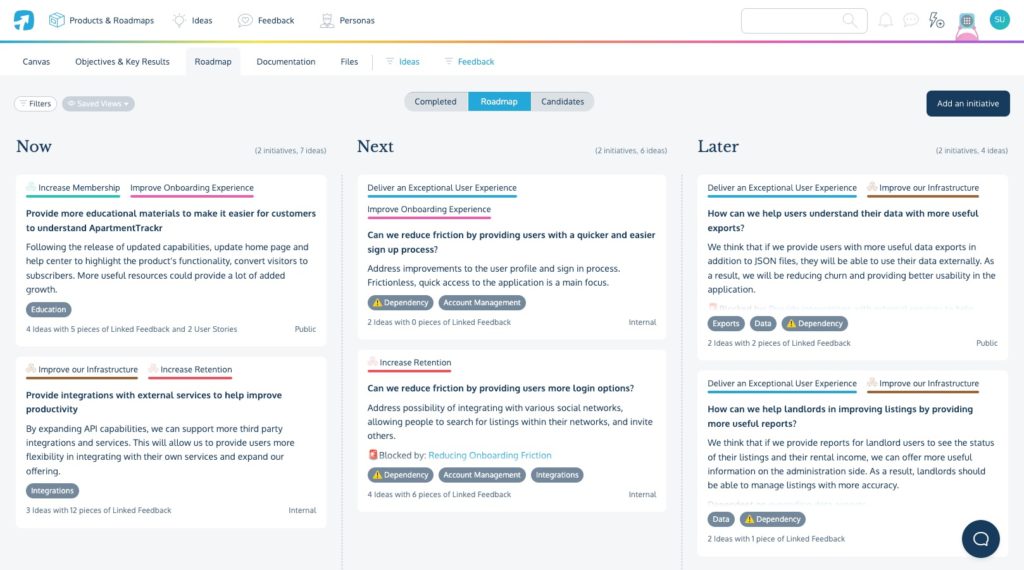New Year, New Product Roadmap – Embrace Roadmap Bankruptcy
As we enter a new year and a new planning cycle, many product people find themselves in a knot about what to include in their product roadmap.
One of the biggest challenges is figuring out how to fit in all the things that weren’t done from last year, AND all the things that have made it to the wishlist for this year. Roadmaps come with a lot of baggage.
Product roadmap bankruptcy
There’s a concept I call Roadmap Bankruptcy, and it’s actually really freeing. If you’ve got a crap roadmap, just go push it all to the side tomorrow and start with fresh eyes. Throw out your old roadmap and start again.
Only when you’ve gone through the process of recreating and checking your assumptions with colleagues about what should be on there, should you go back and compare to your old roadmap.
You might find that there’s a bunch of stuff that didn’t get back on there. Features that seemed important last year, but when stacked against the problems and opportunities you’ve faced this year, they just don’t make as big a difference as you once thought. That’s okay and healthy! It’s a sign that you and your team are learning and adapting based on what you’re seeing in the market and with your customers’ needs.
Anything that didn’t get added back in represents a whole bunch of unnecessary work that you just avoided for you and your team. There’s nothing more lean than that!
You’ll also probably find that new initiatives will find their way into your product roadmap this year—things that weren’t even mentioned in a previous roadmap. This is healthy too. Oftentimes, the act of putting aside your attachments to previous plans—ie. Last year’s roadmap—means you can think more freely and openly about what you should really be working on.
Try this out today:
A risk-free way to rethink your roadmap and check if you’re on the right path.
Step 1: Starting afresh
Save your existing roadmap somewhere safe. You’ll refer back to this later, but you probably won’t return to that particular roadmap again. You’re starting afresh 😎
Step 2: Start a free trial
Start a ProdPad trial, and head on over to the Roadmap builder page for your product. It gives you lots of space to work through the initiatives and related product work ahead.
Step 3: Create initiatives
In the Candidates column, create initiatives to represent each problem or opportunity that lays ahead for your business. These aren’t generally feature-related, but a level above—more like the problem that needs to be solved. We’ll add potential solutions and feature-level details later on, but it’s important to start with problems.
Our product experts sometimes find it helpful to phrase these initiatives like questions, rather than like statements.

Step 4: Prioritize these problems into Now-Next-Later
Don’t feel like you have to get this perfect on your first stab. Your aim here is to lay out the steps you think the product should take in order to progress towards the objectives and vision that have been outlined.
Think of this process more like prototyping rather than ‘pixel-perfect’ designing your plan. Your goal is to lay out your assumptions of what problems exist and which order you could tackle them to maximize your success, and then use your roadmap to share those assumptions with others so they can be checked and adjusted.
The more open and flexible your roadmap is at this point in time, the more robust of a strategy you’ll ultimately come up with.
Step 5: Roadmap solutions
Map out potential ideas or experiments that could solve each problem. Once you have a good idea of the overarching steps in the strategy (the set of problems to be solved, and the order you’ll tackle them), you can start seeing how you might break it down into concrete product experiments and iterations that’ll make the impact you’re aiming for.
In general, you want to identify at least 3-5 different experiments (we call them ‘Ideas’ in ProdPad) that could be run to try to solve each problem identified on the roadmap. This way, you’re not ‘falling in love with your idea’, a warning shared by Teresa Torres when she talks about her Opportunity Solution Tree (which works really well in conjunction with the ProdPad format of Now-Next-Later!)
Step 6: Compare with your old roadmap
Compare your new Now/Next/Later roadmap with the one you left off within Step 1. What new problems did you identify that you’d missed off with your previous version? If these are, in fact, important problems, then this roadmapping exercise has been well worth it! Anything that helps identify problems that might have been unrecognized or uncommunicated is time well spent.
What was left off the new roadmap? Now that they didn’t fit the mold for your new year’s plans, are they really that important? If you forgot something that was truly important, then it’s a good time to reassess this new roadmap and figure out where these sit in the bigger picture. More important or less important than the other things you and your team identified?
You will almost certainly find that some things are left off the roadmap, and frankly, don’t need to be added back on. By taking this step back, you’ve been able to put your fresh eyes on things and see a new path to meeting your goals.
Step 7 and beyond…
Continue sharing and iterating on this new roadmap as you learn more and more each day this year.
